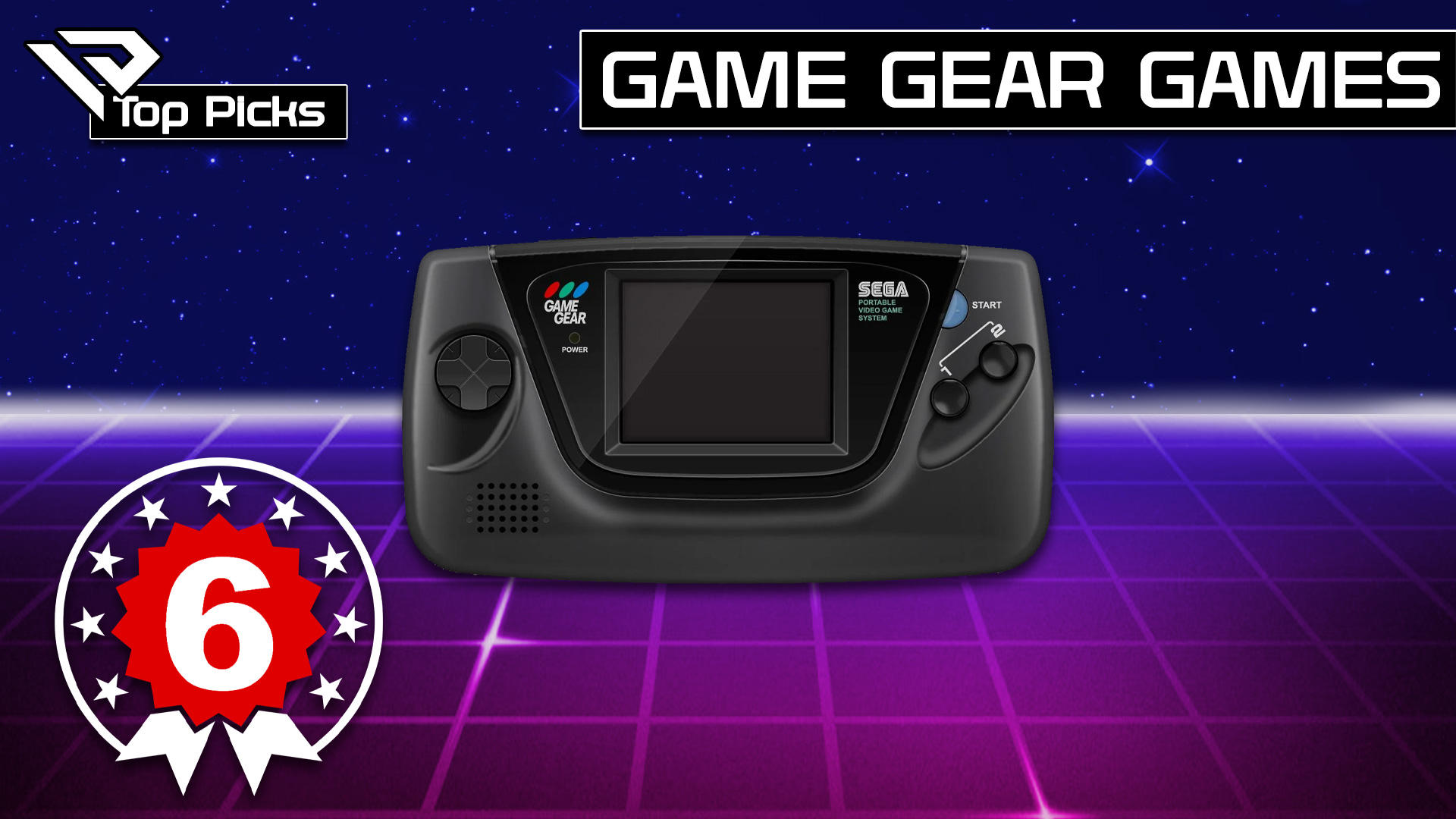The Game Gear is an 8-bit fourth generation handheld game console released by Sega. Developed under the name “Project Mercury”, the Game Gear was first released in Japan on October 6, 1990, in North America and Europe in 1991, and in Australia in 1992. Originally retailing at JP¥19,800 in Japan, US$149.99 in North America, and GB£99.99 in Europe, the Game Gear was developed to compete with the Game Boy, which Nintendo had released in 1989.
The decision to make a handheld console was made by Sega’s CEO Hayao Nakayama and the name was chosen by newly appointed Sega of America CEO Michael Katz. Both Sega’s chairman Isao Okawa and cofounder David Rosen approved of the name. The console had been designed as a portable version of the Master System, and featured more powerful systems than the Game Boy, including a full-color screen, in contrast to the monochromatic screen of its rival. According to former Sega console hardware research and development head Hideki Sato, Sega saw the Game Boy’s black and white screen as “a challenge to make our own color handheld system.”
To improve upon the design of their competition, Sega modeled the Game Gear with a similar shape to a Genesis controller, with the idea being that the curved surfaces and longer length would make the Game Gear more comfortable to hold than the Game Boy. The console’s mass was carefully considered from the beginning of the development, aiming for a total mass between that of the Game Boy and the Atari Lynx, another full-color screen competing product. Despite the similarities the Game Gear shared with the Master System, the games of the latter were not directly playable on the Game Gear, and were only able to be played on the handheld by the use of an accessory called the Master Gear. The original Game Gear pack-in game was Columns, which was similar to the Tetris cartridge that Nintendo had included when it launched the Game Boy.
With a late start into the handheld console market, Sega rushed to get the Game Gear into stores quickly, having lagged behind Nintendo in sales without a handheld on the market. As one method of doing so, Sega based the hardware of the Game Gear on the Master System, albeit with a much larger color palette than its predecessor: the Game Gear supported 4096 colors, compared to the 64 colors supported by the Master System. Part of the intention of this move was to make Master System games easy to port to the Game Gear. Though the Game Gear was designed to be technologically superior to the Game Boy, its design came at a cost of battery life: whereas the Game Boy could run for more than 30 hours on four AA batteries, the Game Gear required six AA batteries and could only run for three to five hours. With its quick launch in Japan, the handheld sold 40,000 units in its first two days, 90,000 within a month, and the number of back orders for the system was over 600,000. According to Sega of America marketing director Robert Botch, “there is clearly a need for a quality portable system that provides features other systems have failed to deliver. This means easy-to-view, full-color graphics and exciting quality games that appeal to all ages.”
In this episode, we are going to checkout the Best Game Gear Games Growing Up in the Philippines.
Why Top 6? Because Top 10’s are everywhere and Top 5’s are not rare. Do you know what sticks? It is my top 6!
But first, take a second to hit on the Subscribe button so you will never miss another episode of my weekly Top 6.
Now let us go through the list and let us see how many of your favorite Game Gear games I considered the best.
6. Paperboy (1991)
1991 | Tengen

Paperboy often sits forgotten in SEGA’s back catalogue. I mean, many of us resented having to get up and head out on our paper rounds as kids, so why would we want to do it virtually.
Well, there’s no chance of getting wet or chased by a dog in these virtual suburbs. It takes little brain power and is one of those addictive games that once started is impossible to put down.
Paperboy has a duration of seven in-game days. The aim of the game is to deliver papers properly; points are awarded for throwing papers into boxes and taken away if you damage houses.
Yeah, this kid throws hard!
Pull off slick tricks and make people’s mornings 10x better. Well, that is if you get the right papers to the right houses on the right days, of course!
5. Streets Of Rage
1992 | Sega

I still remember trying to convince my friend to let me borrow his SEGA Game Gear for a couple of weeks so that I could carry on playing this after I went round to his house.
It was button mashing heaven and a really great way to let off steam after a hard day in the playground (those early years of school can be tough!).
Streets Of Rage is one of the best side-scrolling brawlers ever made, and while I like a bit of Street Fighter when it comes to whooping ass and using insane moves, Streets Of Rage has that addictive allure that keeps pulling you back in to try and defeat the absurdly humongous enemies at the end of each round.
Having the ability to take S.O.R out into the open changed gaming for a lot of people and made it easier to carry on playing when you had to go home from your mates or head out to the supermarket.
With the SEGA Game Gear in tow, you didn’t have to admit defeat when your TV time was up; you could carry on playing in secret and keep the fight alive.
I often think about Adam, Axel, and Blaze trying to clean up the streets and rid the world of Mr X’s henchmen, and I wonder how many other ex-police officers have looked to Streets Of Rage as a light at the end of the tunnel after their career.
Probably none; no one in their right mind would try and take down bosses that big!
4. Road Rash
1993 | Electronic Arts

Before we had the luxury of whipping out Cro Mag Rally on our iPhones or kicking back with Mario Kart 8 on the Switch, good handheld racers like the next title on our list of the best SEGA Game Gear Games were few and far between.
Road Rash is a beastly little game based around Motorcycle racing, with many ‘road rage‘ inducing features that we would come to love in games such as SSX Tricky and Grand Theft Auto later on in life.
With levels based in some of the top locations in America, players must use quick steering skills in a series of five races to become king or queen of the asphalt.
And if you’re no good at steering, you can always punch, kick, or backhand neighbouring opponents as you speed towards the finish line.
Anything goes in Road Rash!
Instead of contending with bananas and chain chomps, players have to watch out for baseball bats and chains as they swerve in and out of the other racers, all while trying to avoid causing too much damage to their bike and themselves…
… which in a game like this is harder than it sounds!
This is one of the most high-octane racers on the SEGA Game Gear and a title in which anything can happen at any given time.
It’s not just enough to be able to know the course like the back of your hand, in fact, you can’t see the back of your hand because there’s a chain wrapped around it.
Electronic Arts, you are too good to us!
3. Mighty Morphin’ Power Rangers
1995 | Bandai

I was considering just writing ‘because who doesn’t love Power Rangers’, and leaving it at that, but I figured you might be hoping for something a little bit more informative.
I lived and breathed Power Rangers growing up; I had the figures, the Zords, the swords, but I never had the game!
Yes, I know it’s shocking, but I can only hope that putting it in this list of best SEGA Game Gear Games as an adult will make up for the mistakes that I made as a child.
The Game Gear version was one of only two versions that allowed you to use the Green Ranger and the Dragonzord too, which makes it instantly better than the un-green SNES version.
Using a variety of classic and signature moves, you can work your way through a story mode, a link-up battle mode, or a single-player button mash battle mode.
You can play as your favourite character (or colour if you’re not a nerd), and face up to some of the enemies (of which there are a LOT) that you will have seen on the ever-popular TV show.
Oh, and you can play as the MegaZord; who doesn’t love the MegaZord?
2. Ristar
1995 | Sega

Ristar takes the 2nd spot in this list of the best SEGA Game Gear games of all time!
Would you believe that Ristar was actually supposed to go up against Mario? This little star was going to be SEGA’s mascot was well and truly ‘outshined’ (pun intended) by Sonic.
Still, we’re not here to poke fun of Ristar; this is a fantastic game that offers an alternative set of levels to the Genesis/Mega Drive version.
Fans will love the re-ordered planets and new additions to the Game Gear cart. There are also 100 little starts to collect on each level, giving the player a much-needed 1UP life to use on the later levels.
This game has a strong James Pond meets Sonic vibe to it, and that’s never a bad thing. It’s catchy and fun, albeit a little short.
Also, am I the only one who thinks those green columns look a little like The Grinch?
1. Sonic The Hedgehog 2
1992 | Sega

The results are in, and the people have spoken (by people, I mean myself); Sonic The Hedgehog 2 is the greatest SEGA Game Gear game of all time!
I love the first Sonic the Hedgehog game, but you just can’t deny how amazing the sequel is.
It’s the polished diamond, or in this case, the polished chaos emerald of Sega’s collection.
Out of every console console Mascot, Sonic is definitely the coolest. I love Mario, but come on, a supersonic Hedgehog vs a plumber… there’s no comparison.
The levels in this game are second to none, and being able to play as Tails for the first time in a Sonic game was a momentous moment. Where were you the first time you remember taking Miles out for a spin?
This timeless classic ported so well to the Game Gear too, with fans relishing the chance to take Sonic out into the world with them.
Until they could take Sonic & Knuckles out on the SEGA Nomad, this was the ultimate portable SEGA game experience!
And that’s it for my Top 6 Game Gear games growing up in the Philippines and a big thanks for watching. Did I miss some of your favorite games? Let me know by commenting below!

